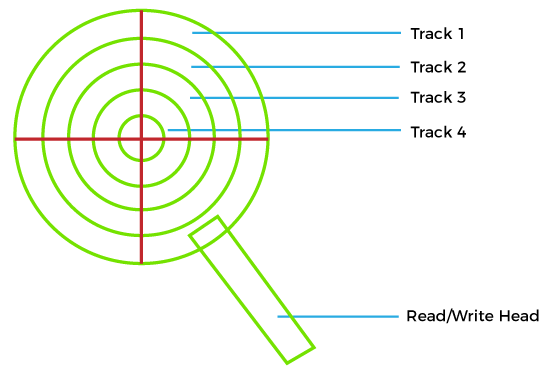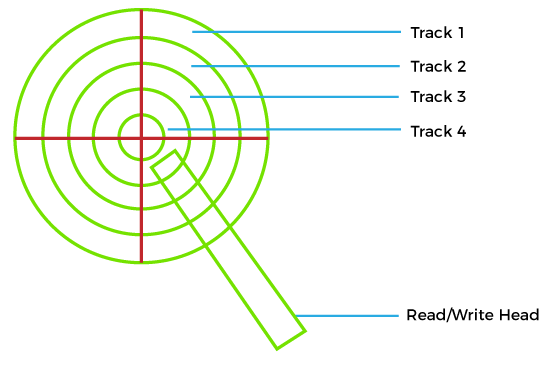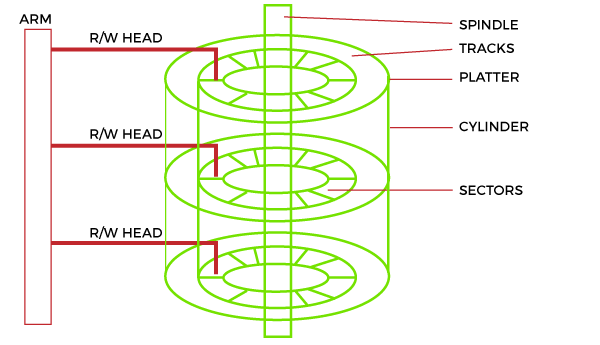Difference between Seek Time and Disk Access Time in Disk Scheduling
In this article, you will learn about the difference between the seek time and disk access time, But before discussing the differences, you have to know about the seek time and disk access time in Disk Scheduling.
What is Seek Time in Disk Scheduling?
Seek time is the time taken for a hard disk controller to locate a specific piece of stored data. Seek time can vary upon where the head is present when the read/write request is sent.
When anything is read or written to a disc drive, the read/write head of the disc moves to the right position. The actual physical positioning of the read/write head of the disc is called seeking. The time the read/write head of the disc takes to move from one disk to another is called the seek time.
The seek time can be different for a given disc due to the varying distance from the start point to where the read/write head has been instructed to go. Because of this, seek time is generally measured as an average seek time. Seek time is also measured in two other ways, track to track and full stroke.
- Track to track is the time read/write head takes to search or seek between adjacent tracks. It is measured in milliseconds, which is usually in 2 to 4 ms and as low as 1 ms.
- Full stroke is the amount of time required to seek the whole disc. Full stroke is also measured in milliseconds, and a seek time below 10ms is generally considered acceptable for a hard disk.
The operating system requests the drive controller firmware to get a hard disk to read information, which actuates the read/write head to move to the position where the required data is stored. Switching between tracks requires the head actuator to move the access arm, which takes a certain amount of time. This time is called the seek time. It can vary depending on the distance between tracks and from its origin at the time of each read /write command.
Because there are no industry standards for recording seek time, no single number determines the seek time for the whole drive. This is why most disc drive manufacturers measure the seek time in averages, and some manufacturers also include the full stroke and track to track specifications.
For example,
Consider a hard disk of the concentric circle called tracks, and you want to fetch some data, but the read/write head is currently on track 1, as shown in the below diagram.

But the user request data that is present on Track 4. In this case, the read/write head will move to track 4 shown in the below diagram. The time it will take to reach track 4 is the seek time.

Seek time is the time needed for the head to move from its current track (track 1) to where the data is present (rack 4). Even after this, it might have to wait for some more time because the data is present on the opposite side of the track, and this delay is called Rotational Latency, but this isn’t counted in Seek Time.
What is Disk Access Time in Disk Scheduling?
Disk Access Time is defined as the total time required by the computer to process a read/write request and then retrieve the required data from the disk storage.
There are two components in disk access time. The first component is the seek time which occurs when the read and write arm seeks the desired track. The second component is latency or wait time which occurs when the head write arm waits for the desired sector on the track to spin around.

Access to the data on disks is measured in terms of milliseconds. However, this is actually much slower than the processing speeds of CPUs. Although I/O is still slow, it cannot match the speed improvements of modern processors. Disk Access Time is divided into two parts:
- Access Time
- Data Transfer Time
Formula
You can calculate the disk access time by using the following formula.
1. Access Time
Access Time is defined as the setup time before the actual data transfer takes place. For example, the read/write head is on track 1, but we need to read data from another track or segment. Thus, the read/write head will move to the data block location before the actual transfer occurs. This delay is called Access Time. Access Time is calculated by summation of the following:
- Seek Time: The time the read/write head takes to reach the desired output. It is known to be the most important time because it cannot create a gap. Seek time is inversely proportional to the performance. So the lesser seek time, the better will be the performance.
- Rotational Latency: The time read/write head is required to move from the current to the requested sector.
- Command Processing Time: It is the time required by the disk device to process the command and establish a connection between the various components of the disk device to read/write data. It is due to the internal circuitry.
- Settle Time: Settle time is the time required by the read/write head to stop vibrating.
NOTE: Command Processing Time and Settle Time are not normally mentioned in the numerical question, and we take them as zero.
2. Data Transfer Time
Data Transfer Time is defined as the time required to transfer data between the system and the disk. Data Transfer Time is two types:
- Internal Transfer Rate: It is defined as the time required to move data between the disk surface and the hard disk cache.
- External Transfer Rate: It is defined as the time required to move data between the hard disk cache and the system.
Difference between Seek Time and Disk Access Time
Below are some differences between rotational latency and disk access time in disk scheduling, such as:

| Seek Time | Disk Access Time |
|---|---|
| Seek time is the time taken by the head to move from the current track to the one where data is present. | Disk access time is the time required by the computer to process a read/write request and retrieve the required data. |
| Seek time is always less than Disk Access Time, and since it is a sub-part of Disk Access time. | Disk access time is very large compared to Seek time. |
| Seek time doesn’t consider a transfer of data. | Disk access time considers the time required to transfer data. |
| Seek time can vary a lot depending upon the distance between the current and final position and how it has been instructed to go. | Disk Access Time depends on two parts, i.e. access time and data transfer time. |
| Seek time is usually between 10-20 ms, depending upon the RPS and drive grade. | We can reduce Disk Access Time if we can reduce access time and data transfer time. |
| Seek time is measured in Average Seek Time. | Disk Access Time, = Seek time + Rotational Latency + Data Transfer Time |
